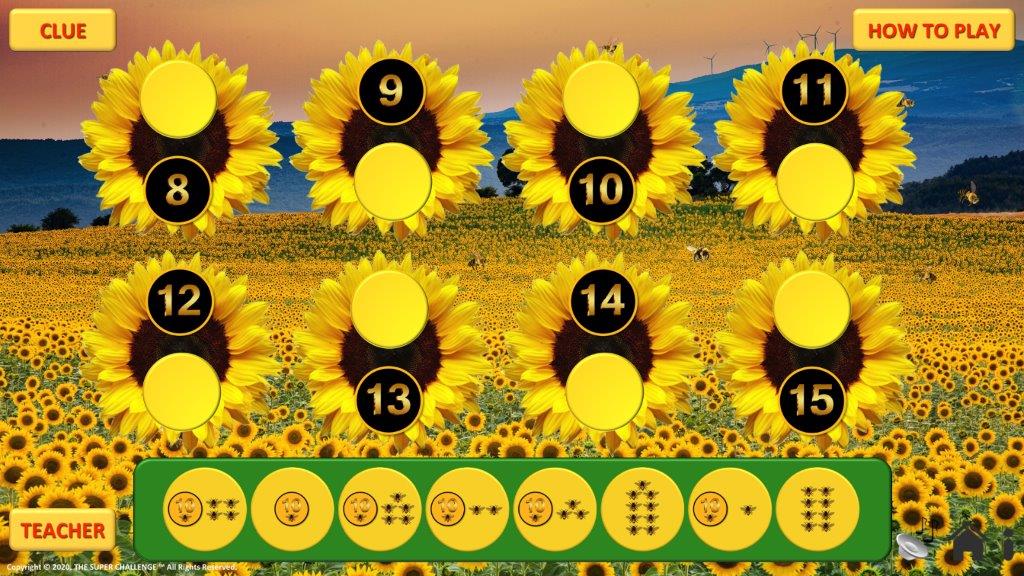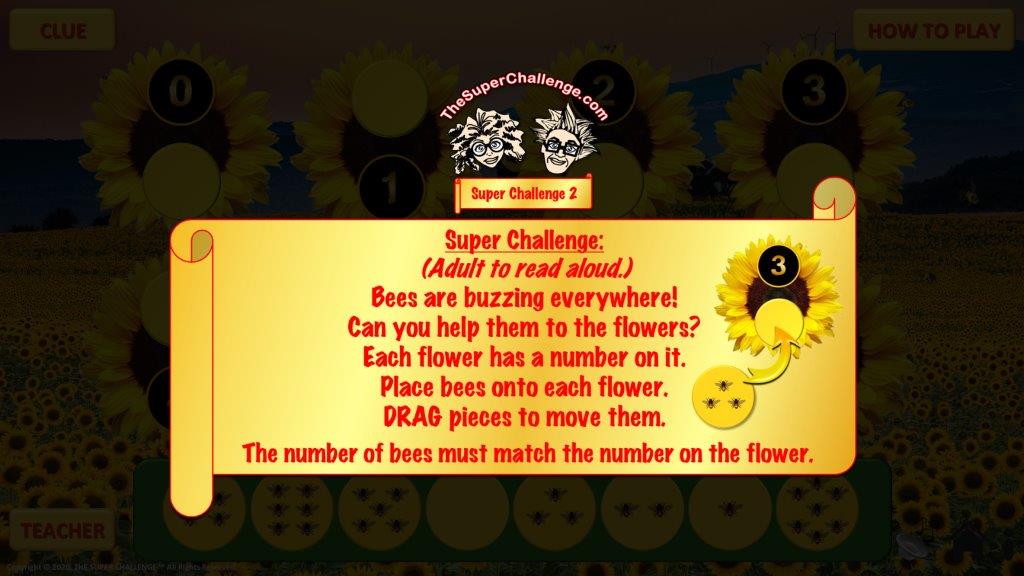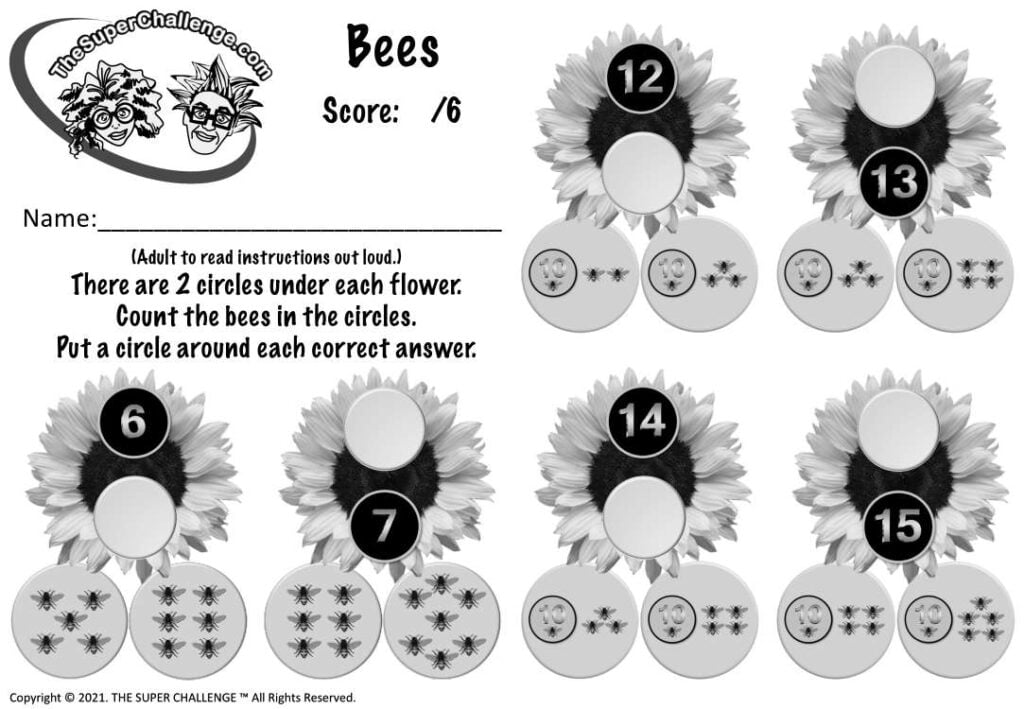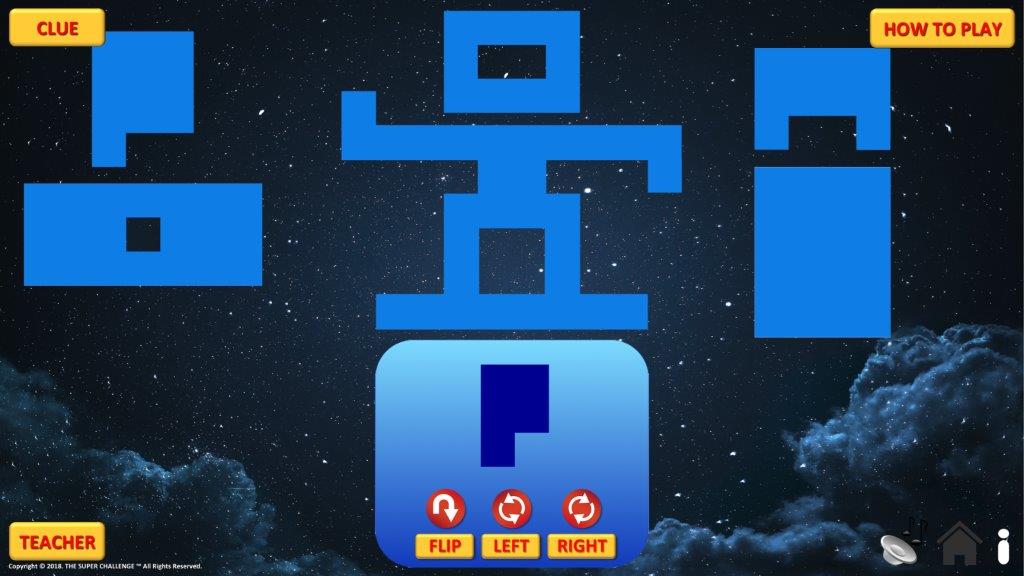YOUR SUPER CHALLENGE:
(Adult to read aloud.) Your challenge is to complete any 3 games from the list below. A game is only completed when you finish all the questions in the game. You may try some games first to see which ones you would like to play. If you shut the game down, you will have to play from the start again. If you write down your answers on the worksheet as you play, you can catch up to where you left the game. (The worksheet is optional.)
When you have fully finished any 3 games, you have completed your challenge and may download your Certificate of Congratulations! But don’t stop there, challenge YOURSELF to see how many more games you can complete!
PARENTS & TUTORS:
As students at this level cannot read, games need to be played with an adult. Please note, games are not designed to be played on Safari browsers and may not load. All games may be played on PC’s & laptops; however, some may also be played on tablets, see the listing under each game name.
Warning: Games are not designed to be played using the Safari browsers.
Games should only be played using a web browser such as Chrome, Firefox or Microsoft Edge.
Please open this website using one of these browsers.
It is also advised you have the latest version of the Chrome, Firefox or Microsoft Edge web browsers.
Foundation – Grade 1 Explained

BIRDS AND CATS
GAME PLAYS ON: PC, LAPTOP & TABLET
Birds and Cats - Game Description
Ages: 4 – 5 years old.
Learning position and movement with basic shapes, for foundation students.
Foundation includes: Preschool, Reception, Pre-kindergarten, Kindergarten, Pre-primary and Year 1 in England.
This is an educational mathematics game helping foundation level students to grasp the concepts of position and movement. With help from an adult, it is also a good game to teach the language of location and direction, such as ‘between’, ‘near’, ‘next to’, ‘forward’ & ‘toward’. It is fun to play and very engaging for the age group. It is also a good exercise to learn basic shapes and to improve spatial awareness.
Teacher References:
(ACMMG010): Describe position and movement. Interpreting the everyday language of location and direction, such as ‘between’, ‘near’, ‘next to’, ‘forward’, ‘toward’.
(ACMMG009): Sort, describe and name familiar two-dimensional shapes.
Ref: Australian Curriculum Mathematics.
How To Play:
(Adult to read aloud.)
Use the shapes to make the cat. Then can you make the bird? Drag the shapes to move them. Then you can FLIP or TURN each one to fit. It might get tricky, but you can do it! Can you name 3 of the shapes? (See the worksheet.)
Adult/Teacher: Please use words such as “near”. next to” and “between” when asking your student questions.
Birds and Cats - Learning Outcomes

Birds and Cats - Worksheet
BEES
GAME PLAYS ON: PC, LAPTOP & TABLET
Bees - Game Description
Ages: 4 – 5 years old.
Subitise, name & connect numerals & quantities to 15, for foundation students.
Foundation includes: Preschool, Reception, Pre-kindergarten, Kindergarten, Pre-primary and Year 1 in England.
This game helps students learn to subitise numbers in preparation to learning addition. It also helps them name numbers and connect numbers to quantities up to 15.
The game is beneficial on many levels as it also prepares students for addition. The examples given to students include subitising, so they may identify collections without having to count them individually. With the help from an adult, student also name numbers and connect numerals and quantities. It is fun to play and is filled with sounds of nature making it a very calming way to learn numbers.
Teacher References:
(ACMNA003): Subitise small collections of objects. Using subitising as the basis for ordering and comparing collections of numbers.
(ACMNA001): Establish understanding of the language and processes of counting by naming numbers in sequences, moving from any starting point.
(ACMNA002): Connect number names, numerals and quantities, including zero, initially up to 10 and then beyond.
Ref: Australian Curriculum Mathematics.
How To Play:
(Adult to read aloud.)
Bees are buzzing everywhere! Can you help them to the flowers? Each flower has a number on it. Place bees onto each flower. Drag pieces to move them. The number of bees must match the number on the flower. It might get tricky, but you can do it!
Bees - Learning Outcomes

Bees - Worksheet
DAYS OF THE WEEK
GAME PLAYS ON: PC & LAPTOP ONLY
Days of the week - Game Description
Ages: 4 – 5 years old
Learning the days of the week by connecting days to familiar events or actions, for foundation students.
Foundation includes: Preschool, Reception, Pre-kindergarten, Kindergarten, Pre-primary and Year 1 in England.
This game teaches foundation level students the days of the week. With the help from an adult, students are asked to match days of the week with familiar events or actions. It makes learning the order of weekdays easy by pictures of hands and fingers. Students are asked to recite days out loud as they use their fingers to count and represent each day. This game is also focused on building student confidence in mathematics. It includes many positive affirmations and is really fun to play.
Teacher Reference:
(ACMMG008): Connect days of the week to familiar events and actions.
Choosing events and actions that make connections with students’ everyday family routines.
Ref: Australian Curriculum Mathematics.
How To Play:
(Adult to read aloud.)
Do you know the days of the week? Let’s use your fingers to name each one, then we will see if you can remember them. What do you do on a Wednesday? Which finger is Wednesday? Can you name the day before Wednesday? Are you ready for the challenge?
Days of the week - Learning Outcomes

Days of the Week - Worksheet
THE FOREST
GAME PLAYS ON: PC & LAPTOP ONLY
The Forest - Game Description
Ages: 4 – 5 years old.
Sorting, classifying and matching two-dimension shapes, for foundation students.
Foundation includes: Preschool, Reception, Pre-kindergarten, Kindergarten, Pre-primary and Year 1 in England.
This game teaches foundation level students to identify, sort and match shapes. Beautifully set in the forest, with birds singing in the background, makes it a pleasing and calming game to play. With the help of an adult, students are asked to compare familiar objects and explain the basis for these classifications. Students then match two-dimensional shapes based on common characteristics. They also learn to connect number names and quantities, up to 11. The game is also focused on building student confidence in mathematics as it includes many positive affirmations.
Teacher Reference:
(ACMMG009): Sorting and matching two-dimensional shapes.
Describing familiar two-dimensional shapes in the environment.
Ref: Australian Curriculum Mathematics.
How To Play:
(Adult to read aloud.)
You are in the forest and leaves have dropped on the ground. Can you match them up with their shadows? You must look carefully at each one and it may be tricky! Can you match-up every leaf?
Are you ready for the challenge?
The Forest - Learning Outcomes

The Forest - Worksheet
DUCKLINGS
GAME PLAYS ON: PC & LAPTOP ONLY
Ducklings - Game Description
Ages: 4 – 5 years old
Connect number names, numerals and quantities up to 12, for foundation students.
Foundation includes: Preschool, Reception, Pre-kindergarten, Kindergarten, Pre-primary and Year 1 in England.
This game teaches foundation level students numbers, names and quantities up to 12. With the help from an adult, students can learn to say number names as they count ducklings. Set in nature, with sounds of ducks splashing and quacking in a pond. It is an enjoyable and calming game to play. It is also focused on building student confidence in mathematics as it includes many positive and encouraging voice-overs.
Teacher Reference:
(ACMNA001): Establish understanding of the language and processes of counting by naming numbers in sequences.
(ACMNA002): Connect number names, numerals and quantities initially up to 10 and then beyond.
Ref: Australian Curriculum Mathematics.
How To Play:
(Adult to read aloud.)
You are at a pond. Ducklings are swimming close to their mother. Can you count how many ducklings there are? Match them up to the correct number. You will have to count, use your fingers and count out loud. Are you ready for the challenge?
Ducklings - Learning Outcomes

Ducklings - Worksheet
DOTS
GAME PLAYS ON: PC & LAPTOP ONLY
Dots - Game Description
Ages: 4 – 5 years old
Understanding the process of counting by naming numbers in sequence up to 12 and connecting number names, numerals and quantities for foundation students.
Foundation includes: Preschool, Reception, Pre-kindergarten, Kindergarten, Pre-primary and Year 1 in England.
This game helps foundation level students learn to count up to 12. It is an exciting game of mid-range difficulty and a fun way to learn to count. The game helps students understand numbers are said in a particular order and there are patterns in the way we say them. The game helps students understand that each object must be counted only once, that the arrangement of objects does not affect how many there are, and that the last number counted answers the ‘how many’ question.
The game is set with a big red moon rise and night sounds of crickets and owls. It has wolves howling to the moon and creates a fun and exciting atmosphere for students. The game is also focused on building student confidence in mathematics, it includes many positive and encouraging voice-overs.
Teacher References:
(ACMNA001): Establish understanding of the language and processes of counting by naming numbers in sequences.
(ACMNA002): Connect number names, numerals and quantities initially up to 10 and then beyond.
Ref: Australian Curriculum Mathematics.
How To Play:
(Adult to read aloud.)
You are watching the moon rise. Can you hear the wolves howling? How many dots can you see? Will you count dots with me? Are you ready for the challenge?
Dots - Learning Outcomes
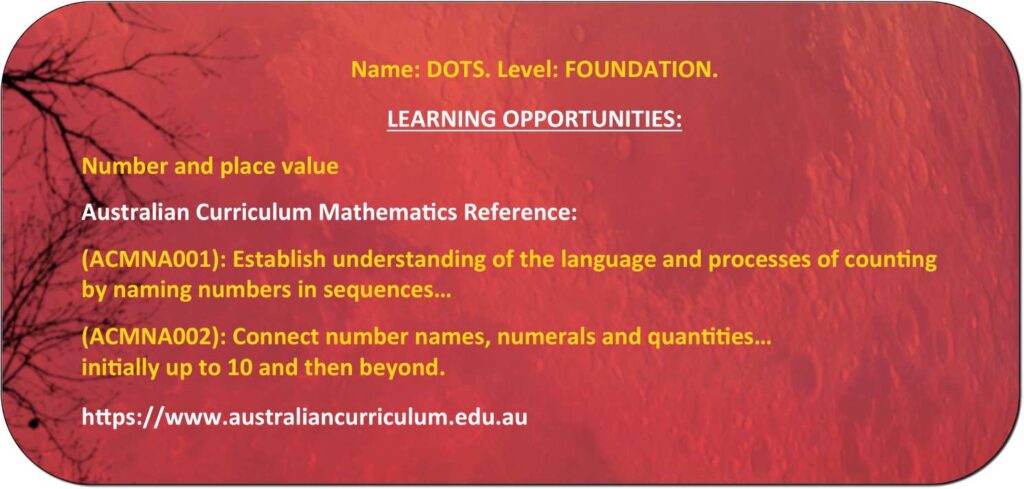
Dots - Worksheet
COVER UP
GAME PLAYS ON: PC, LAPTOP & TABLET
Cover Up - Game Description
Ages: 4 – 5 years old
Learning position, movement and spatial awareness, for foundation students.
Foundation includes: Preschool, Reception, Pre-kindergarten, Kindergarten, Pre-primary and Year 1 in England.
This game helps foundation level students grasp the concepts of position and movement. It is also a good game to teach the language of location and direction, such as ‘between’, ‘near’, ‘next to’, ‘forward’ & ‘toward’. It is fun to play and very engaging for the age group. Full of positive and encouraging voice-overs, it helps build student confidence with mathematics. It is also a good exercise to improve spatial awareness.
Teacher References:
(ACMMG010): Describe position and movement.
Interpreting the everyday language of location and direction, such as ‘between’, ‘near’, ‘next to’, ‘forward’, ‘toward’.
Ref: Australian Curriculum Mathematics.
How To Play:
(Adult to read aloud.)
Can you make these shapes?
Drag the dark blue pieces and cover up the shapes.
You can FLIP, TURN them LEFT or TURN them RIGHT to fit. It might get tricky, but you can do it!
Cover Up - Learning Outcomes

Cover Up - Worksheet
FISH
GAME PLAYS ON: PC & LAPTOP ONLY
Fish - Game Description
Ages: 4 – 5 years old
Compare, order and correspond between collections to 20, for foundation students.
Foundation includes: Preschool, Reception, Pre-kindergarten, Kindergarten, Pre-primary and Year 1 in England.
This game teaches foundation level students numbers, names and quantities, up to 20. Set underwater, with sounds of bubbles and dolphins, it is a pleasant, calming and fun game to play. There are lots of fish and underwater sounds to create atmosphere. It uses groups of fish as examples for students to subitise. Students must then count fish without using their fingers and match the total to a number. This game is also focused on building student confidence in mathematics, it includes many positive and encouraging voice-overs.
Teacher Reference:
(ACMNA289): Compare, order and make correspondences between collections, initially to 20, and explain reasoning.
(ACMNA001): Establish understanding of the language and processes of counting by naming numbers in sequences, initially to and from 20, moving from any starting point.
Ref: Australian Curriculum Mathematics.
How To Play:
(Adult to read aloud.)
You are on a tropical island and can see fish underwater. Can you count how many fish there are? Can you find an easy way to count them without using your fingers? Can you see fish are in groups? Are you ready for the challenge?
Fish - Learning Outcomes
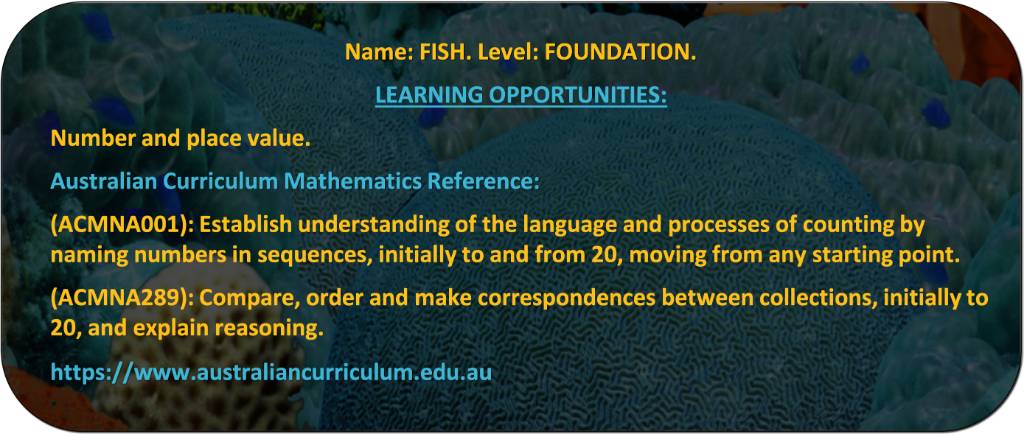
Fish - Worksheet
LADYBIRDS
GAME PLAYS ON: PC, LAPTOP & TABLET
Ladybirds - Game Description
Ages: 4 – 5 years old
Using subitising to order and compare numbers to 20, for foundation students.
Foundation includes: Preschool, Reception, Pre-kindergarten, Kindergarten, Pre-primary and Year 1 in England.
This game helps students learn to subitise numbers in preparation to learn addition. It also helps them name, connect, order and compare numbers up to 20. The game is beneficial on many levels as it also prepares students for learning addition. The examples given to students include subitising, so they may identify collections without having to count them individually. With the help from an adult, students name numbers and connect numerals and quantities up to 20. It is fun to play and is filled with sounds of nature making it a very calming way to learn numbers. This game also includes encouraging voice-overs to build student confidence in mathematics.
Teacher Reference:
(ACMNA003): Subitise small collections of objects. Using subitising as the basis for ordering and comparing collections of numbers.
(ACMNA289): Compare, order and make correspondences between collections, initially to 20 and explain reasoning.
Ref: Australian Curriculum Mathematics.
How To Play:
(Adult to read aloud.)
Ladybirds are supposed to be a good luck charm. Do you like ladybirds? Let’s count them. Place one set of ladybirds onto each yellow circle. Drag pieces to move them. The TOTAL number of ladybirds must match each number. Can you count them? Are you ready for the challenge?
Ladybirds - Learning Outcomes

Ladybirds - Worksheet
POSITIONS
GAME PLAYS ON: PC & LAPTOP ONLY
Position - Game Description
Ages: 4 – 5 years old
Learning the language of location & direction, for foundation students.
Foundation includes: Preschool, Reception, Pre-kindergarten, Kindergarten, Pre-primary and Year 1 in England.
This game helps foundation level students understand location and direction using everyday language, such as ‘between’, ‘near’, ‘next to’, ‘forward’, ‘toward’. The game is also focused on building student confidence in mathematics. It includes many positive affirmations and is really fun to play.
Teacher Reference:
(ACMMG010): Describe position and movement. Interpreting the everyday language of location and direction.
Ref: Australian Curriculum Mathematics.
How To Play:
(Adult to read aloud.)
Where is crazy cat? Next to, behind, on top of, or under something? You are given 4 choices but only one is correct. Which one is it? Are you ready for the challenge?
Adult: Click on one of the picture cards on the start page. Four answer card choices will appear. Please read out each of the answer cards to your student. Ask them to choose the correct answer. Then drag their chosen card to the picture card above to see if it is correct!
Positions - Learning Outcomes

Position - Worksheet
SHAPES CUT UP
GAME PLAYS ON: PC, LAPTOP & TABLET
Shapes Cut Up - Game Description
Ages: 4 – 5 years old
Assembling, describing and naming familiar two-dimensional shapes, for foundation students. (Square, circle, triangle, rectangle & parallelogram.)
Foundation includes: Preschool, Reception, Pre-kindergarten, Kindergarten, Pre-primary and Year 1 in England.
This game helps foundation level students to become familiar with two-dimensional shapes. Students must assemble a square, circle, triangle, rectangle and a parallelogram. It is also a good exercise in developing spatial awareness. It is fun to play and very engaging for the age group. Full of positive and encouraging voice-overs from a wise wizard, it helps build student confidence with mathematics.
Teacher References:
(ACMMG009): Sort, describe and name familiar two-dimensional shapes. (Square, circle, triangle, rectangle & parallelogram.)
Ref: Australian Curriculum Mathematics.
How To Play:
(Adult to read aloud.)
Use the blue pieces to make each shape. Can you see where the pieces should go? Drag the pieces to move them. Then you can FLIP or TURN each one to fit. It might get tricky, but you can do it! Do you know the names of each shape? (See the worksheet.)
Shapes Cut Up - Learning Outcomes

Shapes Cut Up - Worksheet
SORTING
GAME PLAYS ON: PC & LAPTOP ONLY
Sorting - Game Description
Ages: 4 – 5 years old
Learning names and describing three-dimensional objects for foundation level students.
Foundation includes: Preschool, Reception, Pre-kindergarten, Kindergarten, Pre-primary and Year 1 in England.
This game helps foundation level students to sort and describe three-dimensional objects. It teaches students names of shapes such as spheres, cubes, cylinders, pyramids and cones. Students are asked to describe typical three-dimensional shapes they may be familiar with. Set in a forest with sounds of fairies this is a fun and relaxing game for students to play. This game is also focused on building student confidence in mathematics as it includes many positive and encouraging voice-overs.
Teacher Reference:
(ACMMG009): Sort, describe and name familiar two-dimensional shapes and three-dimensional objects in the environment.
This game focuses on three-dimensional objects. For two-dimensional shapes see the game SHAPES CUT UP.
Ref: Australian Curriculum Mathematics.
How To Play:
(Adult to read aloud.)
Do you know your shapes? What shape is a ball? Let’s find out! You will be given 4 choices. Are you ready for the challenge?
Adult: Click on one of the picture cards on the start page. Four answer card choices will appear. Please read out each of the answer cards to your student. Ask them to choose the correct answer. Then drag their chosen card to the picture card above to see if it is correct!
Sorting - Learning Outcomes

Sorting - Worksheet
NUMBERS OF THE WORLD
GAME PLAYS ON: PC, LAPTOP & TABLET
Numbers of the World - Game Description
Ages: 4 – 5 years old
Connect numbers to their written numerals up to 20, for foundation students.
Foundation includes: Preschool, Reception, Pre-kindergarten, Kindergarten, Pre-primary and Year 1 in England.
This game helps foundation level students to understand the language of numbers in sequences to 20, starting from zero. It also explains that the same numbers are used all around the world.
Teacher Reference:
(ACMNA001): Establish understanding of the language and processes of counting by naming numbers in sequences, initially to and from 20, moving from any starting point.
(ACMNA002): Connect number names, numerals and quantities, including zero, initially up to 10 and then beyond.
Ref: Australian Curriculum Mathematics.
How To Play:
(Adult to read aloud.)
Do you know what numbers look like? Numbers are used in every country. Let’s put numbers all around the world! Put them in ORDER from the smallest to the largest. Drag them to move them onto the blue circles. Then you can click the blue box to see if you are correct. Next your challenge will appear! You will have to go from 9 to 20. You can do it!
Numbers of the World - Learning Outcomes
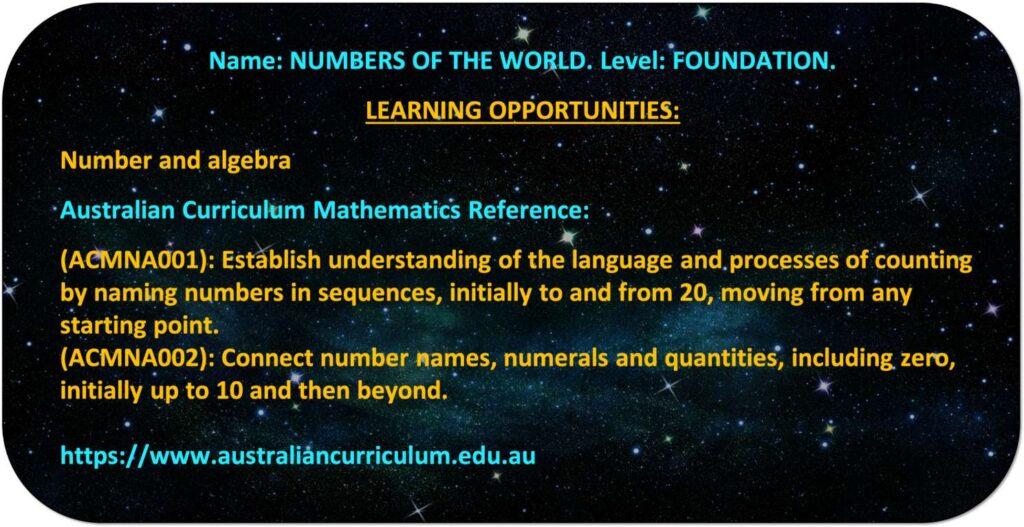
Numbers of the World - Worksheet
CHEETAH CUBS
GAME PLAYS ON: PC & LAPTOP ONLY
Cheetah Cubs - Game Description
Ages: 4 – 5 years old
Learning to count out loud by naming numbers in sequence and connecting number names, numerals and quantities.
Foundation includes: Preschool, Reception, Pre-kindergarten, Kindergarten, Pre-primary and Year 1 in England.
This game helps foundation level students learn to say number names and to count up to 20. With the help from an adult, students are asked to count out loud naming numbers. It helps students understand numbers are said in a particular order and there are patterns in the way we say them. The game uses between 2 and 4 dice and subtly introduces addition.
Set on the plains of Africa, with sounds of cheetahs and other African animals, it is a calming and fun game to play. The game is also focused on building student confidence in mathematics, it includes many positive voice-overs. Encouraging words are used with every achievement level such as, “excellent”, “great job”, “you did it”.
Teacher References:
(ACMNA001): Establish understanding of the language and processes of counting by naming numbers in sequences, initially to and from 20, moving from any starting point.
(ACMNA002): Connecting number names, numerals and quantities, initially up to 10 and then beyond.
Ref: Australian Curriculum Mathematics.
How To Play:
(Adult to read aloud.)
You are on safari in Africa and you can see cheetahs!
You can see that cheetahs have dots. Let’s learn to count dots with dice. How many dots can you see? Will you count dots with me? Are you ready for the challenge?
Cheetah Cubs - Learning Outcomes
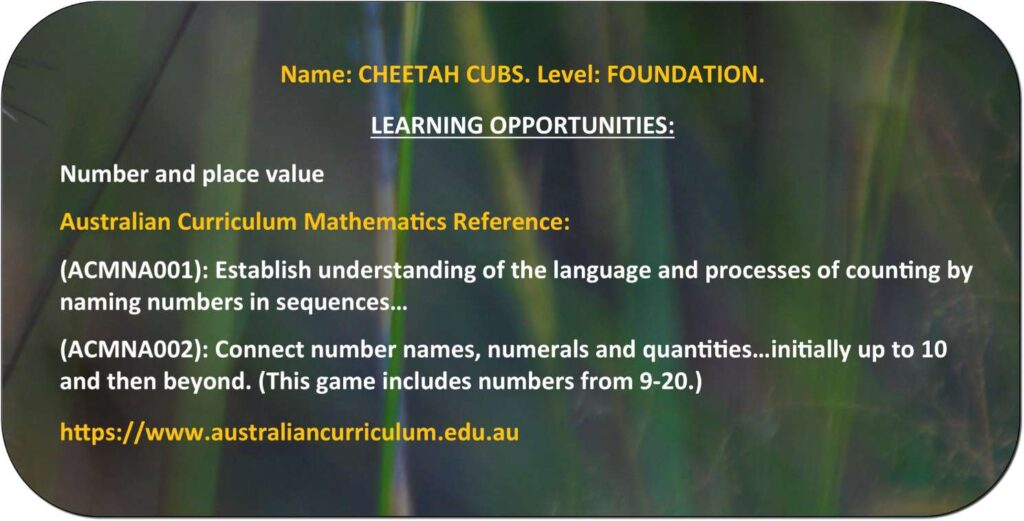
Cheetah Cubs - Worksheet
CUPCAKES AND DONUTS
GAME PLAYS ON: PC & LAPTOP ONLY
Cupcakes and Donuts - Game Description
Ages: 4 – 5 years old
Compare and make correspondences between collections, for foundation students.
Foundation includes: Preschool, Reception, Pre-kindergarten, Kindergarten, Pre-primary, Foundation and Year 1 in England.
Comparing and ordering items of like and unlike characteristics using the words ‘more’, ‘less’, ‘same as’ and ‘not the same as’ and giving reasons for these answers.
This is one of the more challenging games for foundation level students. Students must make comparisons between the number of donuts and the number of cupcakes plus the order they are presented in. The game is also focused on building student confidence in mathematics, it includes many positive and encouraging voice-overs with every step achieved along the way.
Teacher References:
(ACMNA289): Compare, order and make correspondences between collections.
(ACMNA002): Connect number names, numerals and quantities.
(ACMNA003): Subitise small collections of objects.
Ref: Australian Curriculum Mathematics.
How To Play:
(Adult to read aloud.)
Click on a set of cupcakes & donuts.
How many cupcakes can you see? Will you count donuts with me?
Then let’s match up the cupcakes and donuts. It’s tricky but I know you can do it! Are you ready for the challenge?
Cupcakes and Donuts - Learning Outcomes

Cupcakes and Donuts - Worksheet
By the end of the Foundation year, students make connections between number names, numerals and quantities up to 10. Students connect events and the days of the week. They explain the order and duration of events. They use appropriate language to describe location. Students count to and from 20 and order small collections. They group objects based on common characteristics and sort shapes and objects. Students answer simple questions to collect information and make simple inferences.
https://www.australiancurriculum.edu.au










